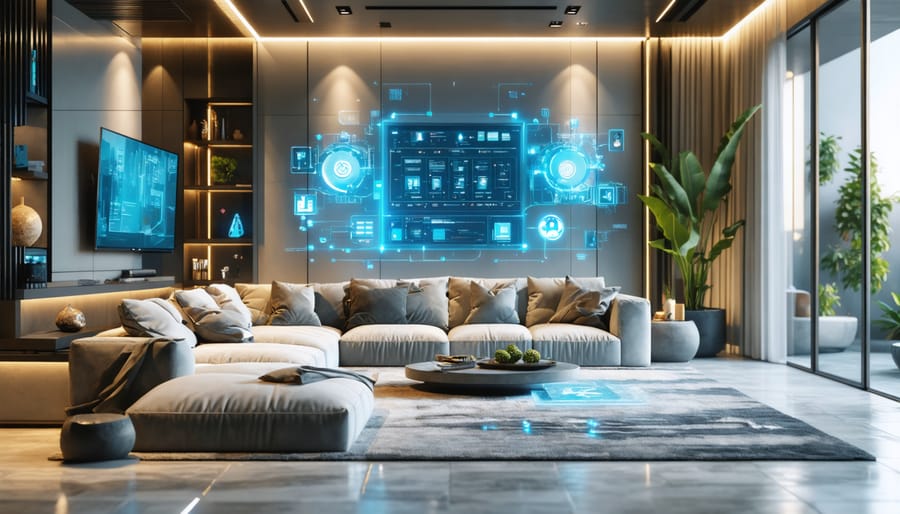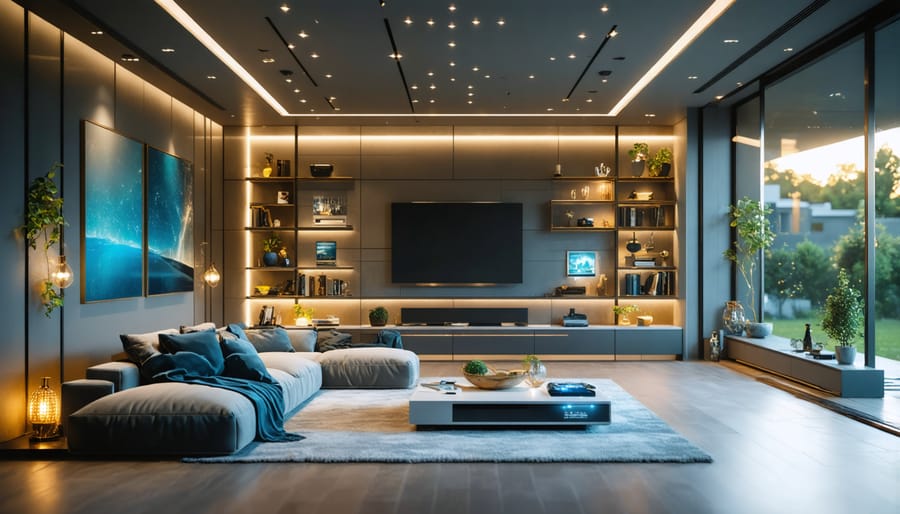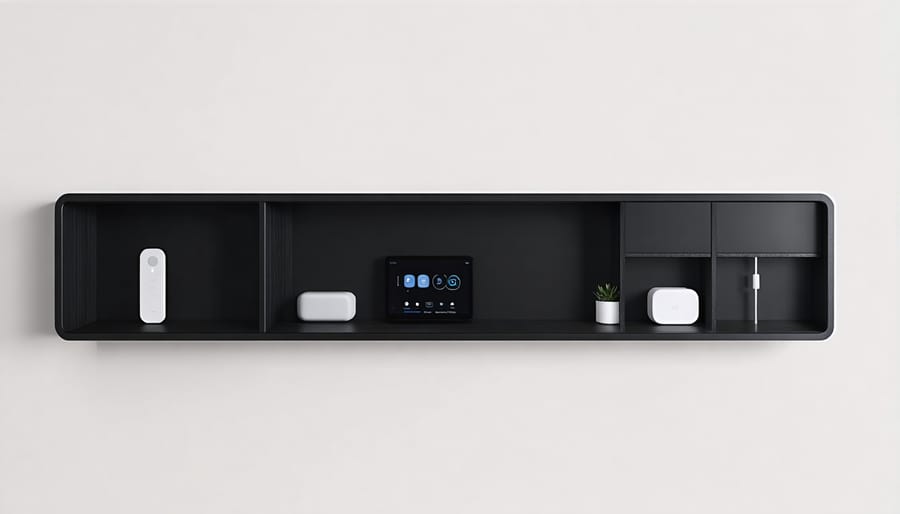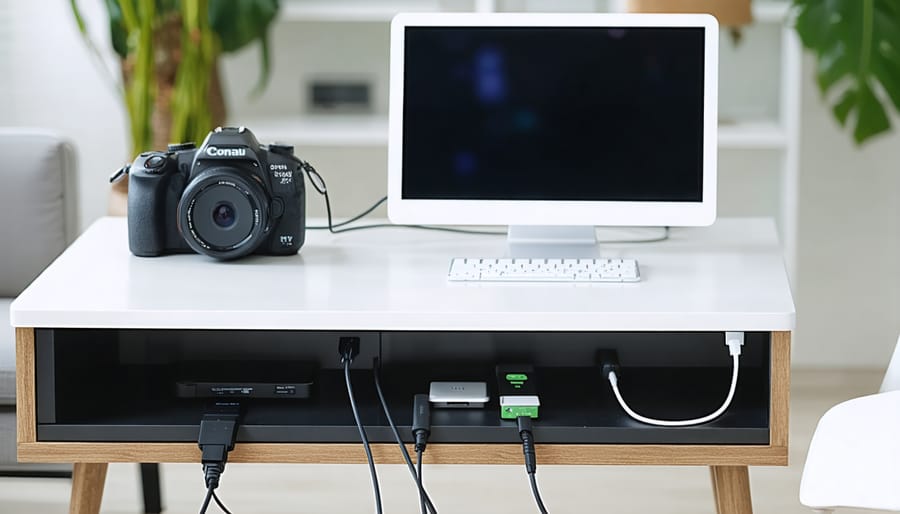
Smart Home Automation That Makes Your Interior Design Shine
Transform your living space into an automated sanctuary by combining smart technology with thoughtful interior design. Modern home automation seamlessly integrates lighting, climate control, and entertainment systems while preserving your home’s aesthetic appeal. Whether you’re starting with a single smart hub or planning a comprehensive whole-house system, this guide will walk you through creating an intelligent, beautiful living environment that responds to your daily needs.
Smart home technology has evolved beyond mere convenience, becoming an essential element of contemporary interior design. From voice-controlled lighting that adjusts to your mood to automated window treatments that optimize natural light and energy efficiency, today’s automation solutions enhance both functionality and style. Learn how to select, install, and customize automated systems that complement your existing décor while creating a more comfortable, efficient, and sophisticated living space.
This step-by-step tutorial combines practical automation expertise with interior design principles, helping you make informed decisions about hardware placement, wire management, and interface design. Whether you’re a tech-savvy homeowner or an interior designer exploring smart home integration, you’ll discover how to create a cohesive, connected environment that looks as impressive as it functions.
Planning Your Smart Interior Design System
Assessing Your Space and Needs
Before diving into automation technology, take a thorough inventory of your living spaces and daily routines. Start by walking through each room and noting your most frequent activities and pain points. Which tasks do you regularly perform? Where do you spend most of your time? These observations will help prioritize your automation needs.
Consider factors like natural light patterns, traffic flow, and existing electrical infrastructure. Map out power outlet locations and network connectivity strength throughout your space. This information is crucial for planning device placement and identifying potential installation challenges.
Create a wishlist of automation features, but be realistic about your budget and technical comfort level. Common starting points include smart lighting for frequently used areas, automated climate control for comfort, and security features for peace of mind. Don’t forget to consider how different family members or occupants will interact with these systems.
Think about both immediate needs and future scalability. While you might start with basic smart lighting, you’ll want to choose systems that can integrate with additional features as your needs evolve. Remember that effective automation should enhance your lifestyle, not complicate it.
Choosing Compatible Systems
When integrating smart devices, compatibility is key to creating a seamless automated home experience. Start by choosing a primary ecosystem like Amazon Alexa, Google Home, or Apple HomeKit as your foundation. This decision will guide your future device selections and ensure everything works together smoothly.
Look for devices that support multiple platforms to maintain flexibility. Many modern smart home products work with several ecosystems, giving you more options and preventing you from being locked into a single manufacturer’s ecosystem. Pay attention to wireless protocols like WiFi, Zigbee, or Z-Wave when selecting devices.
Consider using a smart home hub that can bridge different protocols and systems. Hubs like Samsung SmartThings or Hubitat can help integrate devices that might not otherwise work together. Before purchasing any new smart home product, check its compatibility with your existing setup and preferred ecosystem to avoid frustrating incompatibility issues later.
Remember that some devices may require additional bridges or controllers, so factor these into your planning and budget. This approach ensures a more cohesive and user-friendly automated home system.
Core Automation Elements for Beautiful Interiors
Smart Lighting Design
Modern integrated lighting systems have revolutionized how we illuminate our living spaces, combining functionality with stunning aesthetic appeal. Start by mapping out your lighting zones based on room activities and natural light patterns. Consider installing smart LED strips along crown moldings or under cabinets for subtle accent lighting that adds depth to your space.
Layer your lighting with three key elements: ambient, task, and accent lighting. Smart bulbs in ceiling fixtures provide overall illumination, while automated desk lamps or under-cabinet lights offer focused task lighting. Use color-changing bulbs in strategic locations to create different moods and enhance your interior’s aesthetic appeal.
Program scenes that complement your daily routines – bright, energizing light for morning activities, warm, softer tones for evening relaxation. Install motion sensors in hallways and bathrooms for hands-free convenience and energy efficiency. Consider connecting your lighting to smart window treatments to maximize natural light usage throughout the day.
Don’t forget to group your lights logically in your smart home app. Create zones by room or activity type, making it easier to control multiple fixtures simultaneously. For added convenience, integrate voice commands through popular smart assistants, allowing you to adjust lighting without reaching for your phone or switches.
Remember to choose fixtures that complement your interior design style while maintaining the smart functionality you desire. Modern smart lighting doesn’t mean sacrificing style – many manufacturers now offer sophisticated designs that blend seamlessly with various décor themes.

Climate Control and Comfort
Modern home automation shines brightest when it comes to creating the perfect indoor environment. By implementing smart climate control solutions, you can maintain ideal temperature and humidity levels while complementing your interior design.
Start by installing a smart thermostat as your system’s cornerstone. Popular options like Nest or Ecobee blend seamlessly with contemporary décor while offering powerful automation features. Position temperature sensors strategically throughout your home, hiding them behind artwork or incorporating them into existing fixtures to maintain aesthetic appeal.
For humidity control, consider smart dehumidifiers and humidifiers that can be tucked away in corners or designed to match your room’s style. Many modern units come in sleek, minimalist designs that look more like art pieces than appliances.
Automated blinds and curtains play a dual role in climate management and style. Program them to adjust based on the time of day or temperature, helping regulate indoor conditions while enhancing your room’s ambiance. Choose materials and designs that complement your existing décor while providing optimal insulation.
Don’t forget about smart vents and zoning systems. These can be installed flush with your floors or walls, allowing for precise temperature control in different areas without disrupting your design scheme. Many come with customizable covers to match your flooring or wall colors perfectly.
Window Treatments and Natural Light
Managing natural light is crucial for creating the perfect ambiance in your home, and smart window treatments make this easier than ever. Modern automated blinds and curtains can be programmed to adjust throughout the day, maximizing natural light while maintaining privacy and energy efficiency.
Start by selecting motorized blinds or curtains that complement your home’s style. Popular options include roller blinds for a minimalist look, cellular shades for enhanced insulation, or elegant motorized drapes for traditional spaces. Most systems can be controlled via smartphone apps or integrated with your existing smart home hub.
For optimal light management, consider setting up automated schedules. Program your blinds to open gradually in the morning, creating a natural wake-up experience. During peak sun hours, they can automatically adjust to prevent glare and reduce heat gain, helping maintain comfortable indoor temperatures while protecting your furniture from UV damage.
Smart sensors can further enhance your setup by responding to changing light conditions. These sensors detect brightness levels and automatically adjust your window treatments, ensuring perfect lighting throughout the day. Some systems even integrate with weather apps to prepare for incoming storms or intense sunlight.
Remember to position your motorized controls in easily accessible locations and keep backup battery systems charged. This ensures you can still operate your window treatments during power outages or network disruptions.
Seamless Technology Integration
Hidden Tech Solutions
The art of concealing automation hardware is essential for maintaining a sleek, sophisticated interior design. Start by utilizing existing architectural elements like crown molding, baseboards, and built-in cabinets to house controllers and wiring. Custom-built hollow beams or decorative columns can serve as elegant disguises for cables and automation hubs while adding architectural interest to your space.
Consider incorporating false walls or floating panels that can be easily accessed for maintenance but remain invisible during daily use. Modern window treatments offer excellent opportunities for hiding motorized components – opt for recessed ceiling tracks for automated curtains or built-in window seat compartments for motor housings.
Smart speakers and control panels can be seamlessly integrated into wall-mounted art pieces or decorative mirrors. For lighting automation, choose flush-mounted ceiling fixtures that conceal smart bulbs and controllers, or install cove lighting that naturally hides LED strips and their corresponding hardware.
In entertainment areas, media cabinets with ventilated back panels work perfectly for hiding automation hubs while ensuring proper airflow. Under-furniture mounting solutions are ideal for subwoofers and smaller control units, while strategically placed furniture pieces can mask floor-mounted outlets and charging stations.
Remember to plan access points during installation – removable panels, hinged artwork, or magnetic covers can provide quick entry to hardware while maintaining your room’s aesthetic integrity. The key is thinking creatively about how everyday design elements can double as concealment solutions.

Voice and App Control
Voice and app control represent the cornerstone of modern home automation, offering unprecedented convenience and flexibility in managing your living space. To get started, consider popular voice assistants like Amazon Alexa, Google Assistant, or Apple’s Siri – each offering unique features that can integrate seamlessly with your home setup.
Begin by selecting a primary voice assistant platform that best matches your existing devices. Install the corresponding app on your smartphone and set up your voice-enabled smart speaker in a central location. This will serve as your main hub for issuing voice commands throughout your home.
Next, connect your smart devices through their respective apps, then link them to your chosen voice assistant platform. Most modern smart devices support multiple voice assistants, giving you flexibility in your setup. Create custom voice commands or “routines” that can trigger multiple actions simultaneously – like saying “Good morning” to open the blinds, turn on lights, and start your coffee maker.
For more granular control, utilize manufacturer apps for individual device settings and automation schedules. Many smart home apps now offer intuitive interfaces with drag-and-drop functionality for creating complex sequences. Consider using automation platforms like IFTTT or Home Assistant for advanced integrations between different brands and systems.
Remember to organize your devices into rooms or zones within your control app, making it easier to manage multiple devices and create coordinated scenes for different activities or times of day.
Design-Friendly Automation Tips
Cable Management
Clean, organized wiring is essential for any automated home system, both for functionality and aesthetics. Start by mapping out your cable routes, keeping them away from water sources and heating vents. Use cable raceways or cord covers that match your wall color to conceal visible wires elegantly. These can be painted to blend seamlessly with your interior design.
For under-desk and entertainment center management, invest in cable trays that mount underneath surfaces to keep wires elevated and organized. J-channel cable raceways are perfect for running wires along baseboards or crown molding, creating a clean look while maintaining easy access for future modifications.
Group similar cables together using velcro straps or zip ties, but avoid overtightening to prevent signal interference. Label each cable at both ends using colored tags or a label maker – you’ll thank yourself later during troubleshooting or upgrades.
For power strips and adapters, consider mounting them under furniture or inside cabinets using adhesive strips or brackets. Create dedicated power stations in strategic locations to minimize cable runs across rooms. When running wires between floors or through walls, use properly rated in-wall cables and always consult local building codes.
Remember to leave some slack in your cable runs to accommodate furniture movement and future device additions. This forward-thinking approach ensures your automated system can grow without requiring a complete cable management overhaul.
Smart Furniture Integration
Modern furniture has evolved beyond basic functionality, and incorporating smart furniture solutions into your home can dramatically enhance both comfort and convenience. Start with essential pieces like motorized reclining sofas or adjustable bed frames that can be controlled via smartphone apps or voice commands.
Consider installing power-integrated side tables or coffee tables featuring built-in USB ports and wireless charging pads. These pieces eliminate unsightly cables while keeping your devices powered throughout the day. For home offices, automated standing desks can be programmed with preset heights and reminders to switch positions, promoting better ergonomics.
Storage solutions can also be smart-enabled. Look for cabinets with fingerprint locks or automated opening mechanisms, perfect for securing valuable items while maintaining a sleek appearance. LED-integrated shelving units can be controlled through your home automation system, creating ambient lighting and highlighting display pieces.
In the bedroom, motorized curtain tracks and smart mirrors with built-in displays can transform your morning routine. For dining areas, tables with temperature-controlled surfaces or built-in entertainment systems offer innovative ways to enhance gatherings.
Remember to choose furniture that matches your interior style while incorporating these smart features. The key is finding the right balance between technology and aesthetics, ensuring your automated furniture complements rather than dominates your space.

Embarking on your home automation journey is an exciting step toward creating a more efficient and comfortable living space. Throughout this guide, we’ve explored the essential aspects of integrating smart technology into your interior design, from selecting the right devices to maintaining aesthetic harmony. Remember that automation doesn’t have to happen all at once – start with one room or system that matters most to you, and gradually expand as you become more comfortable with the technology. The key is to focus on solutions that genuinely enhance your daily life while complementing your home’s style. Whether you’re interested in smart lighting, automated window treatments, or a comprehensive home automation system, the possibilities are endless. Take the first step today by implementing one of the solutions we’ve discussed, and you’ll soon discover how automation can transform your living space into a more convenient, energy-efficient, and sophisticated environment.
